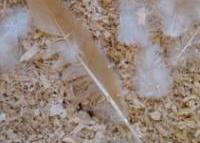Chicken feathers put to use – hydrogen storage

Researchers have discovered that carbonised chicken feathers could provide an inexpensive, environmentally friendly way to store hydrogen fuel for future motor vehicles.
If the concept is proven and accepted by the automobile industry, it could go a long way toward helping to dispose of the 2.7 bln kg of chicken feathers generated each year by commercial poultry operations, reports ScienceNOW Daily News.
Hydrogen is reportedly a leading alternative fuel for vehicles. The byproducts of its combustion are non-polluting, and its source – water – is superabundant. One hitch is the amount of energy required to manufacture it, and another is storing enough of it onboard to give vehicles a cruising range that approaches that of gasoline or diesel fuel.
A team at the University of Delaware, Newark, says it has an unlikely candidate: chicken feathers, which are made of keratin – the same protein in fingernails and beaks – comprise strong, hollow tubes. The team, led by chemical engineer Richard Wool, had been investigating the feathers’ potential for improving the performance of electronic microcircuits. The air inside the tubes helps to speed electrons along the printed wiring, but the feathers weren’t stiff enough to hold the circuit boards together very well. So the team tried a heating technique to strengthen the bonds between the carbon atoms in the keratin.
As the team reported at the 13th Annual Green Chemistry and Engineering Conference in College Park, Maryland, carbonising the feathers gave them a strength approaching that of the nanotubes. They could also store up to 1.7% of their weight as hydrogen, about as much as carbon nanotubes could store. Moreover, the feathers cost virtually nothing to produce. “They’re a nuisance commodity,” says Wool.
The researchers estimate that a hydrogen-storage tank using the carbonised feathers would cost only about $200 when mass-produced. It’s a major step forward, but the US Department of Energy has set a target capacity for hydrogen-storage techniques of 6% of weight, so the carbonised feathers need improvement. Still, Wool is confident that the goal can be achieved.
Source: ScienceNOW Daily News













